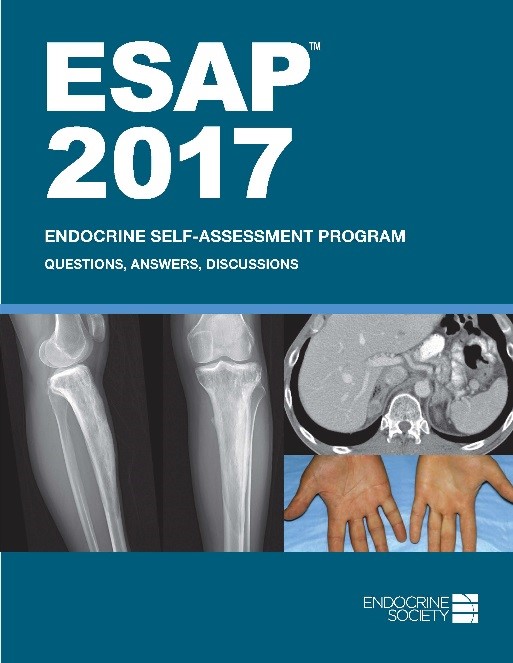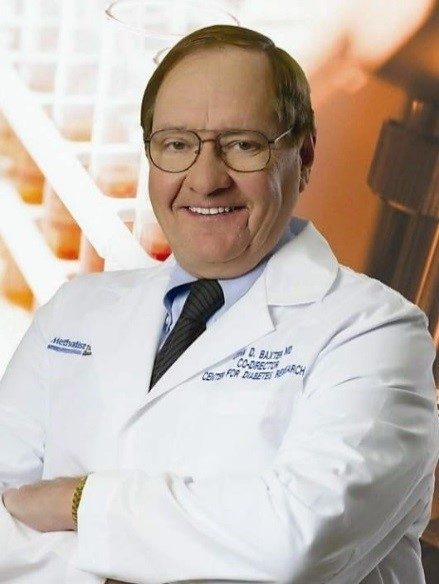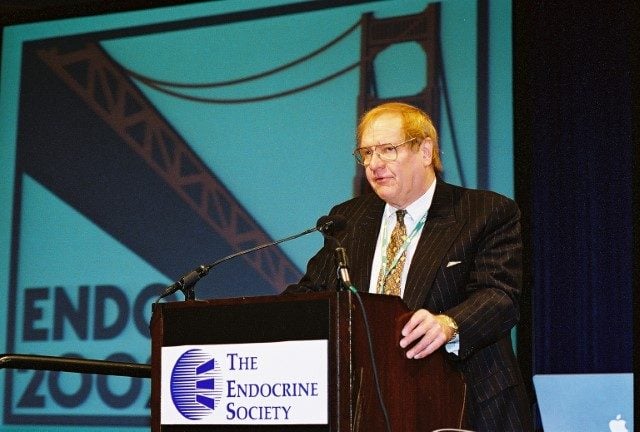
This case highlights newest edition of Endocrine Self-Assessment Program (ESAP), which is also available as a bundle with our special edition ESAP. Available on the online store.
Clinical Vignette
A 32-year-old woman with panhypopituitarism recently moved to your city and sees you in consultation for her ongoing care. At age 12 years a craniopharyngioma was diagnosed and treated with craniotomy followed by radiation therapy. MRI completed 6 months ago showed stable residual craniopharyngioma. Her medications include levothyroxine, hydrocortisone, transdermal estrogen, cyclic oral progesterone, GH, and DDAVP. You assess that her pituitary hormone replacement dosages are appropriate. Her new gynecologist has recommended switching her estrogen and progesterone replacement to a dose-equivalent oral contraceptive pill.
Which of the following is most likely to result by changing her route of estrogen administration from transdermal to oral?
- DDAVP requirement will decrease
- GH requirement will increase
- Hydrocortisone requirement will increase
- Levothyroxine requirement will increase
- No changes will be needed in the dosages of her pituitary replacement hormones
SEE CORRECT ANSWER AND EXPLANATION
Answer: B
GH requirement will increase
Oral estrogen administration inhibits hepatic IGF-1 synthesis, and in women with intact pituitary function, GH secretion increases through reduced feedback inhibition. However, in adults with hypopituitarism who are deficient in GH secretion, the homeostatic mechanism that regulates circulating GH is absent—GH blood levels are completely dependent on the amount of exogenous GH administered. When women with hypopituitarism were prospectively studied, those taking oral estrogen required a mean GH dosage of 867 mcg daily to maintain a mid-normal blood level of IGF-1, compared with women with endogenous estrogen or on transdermal estrogen who required a mean GH dosage of 424 mcg daily. Thus, if the route of estrogen administration is switched from transdermal to oral in the patient in this clinical vignette, the GH dosage will need to be increased to maintain a mid-normal serum IGF-1 level (thus, Answer B is correct and Answer E is incorrect). The route of estrogen administration does not affect replacement dosages of DDAVP (Answer A), hydrocortisone (Answer C), or levothyroxine (Answer D).
Historical Context: Dr. John D. Baxter
Endocrine Society President 2002-2003
Dr. John D. Baxter (Endocrine Society President 2002–2003) made many fundamental medical discoveries and translated them into clinical therapies. His laboratory was an early pioneer in molecular biology and recombinant DNA technology and was first to clone many important genes, including those for rat, human, and bovine GH. His group was the first to show that GH could be produced in bacteria—an advance that revolutionized the production of human GH. From 1957 to 1985, the source of human GH was from pooled cadaver pituitaries. Because of limited supply of the cadaver pituitary product, use was restricted to those children with severe GH deficiency. In addition, it was documented that over time these children treated with cadaver pituitary–derived GH were at risk of developing Creutzfeldt-Jakob disease. With Baxter’s innovation to develop recombinant biosynthetic human GH, the supply limitations were no longer an issue and many more children could be treated without the risk of Creutzfeldt-Jakob disease. In addition, the condition of adult GH deficiency could also be treated, as highlighted in the clinical vignette. Baxter’s work became the prototype for all DNA-based human therapeutics and led to the technologies that are now used throughout the biotechnology industry, as well as in academic research laboratories.
Baxter founded several companies to facilitate making his discoveries available to improve patients’ lives. He was the founder and director of 4 successful biotech companies, the first of which, California Biotechnology, Inc, founded in 1982, was ranked among the top 10 biotechnology companies in terms of market capitalization by the time it was acquired by Johnson & Johnson for $2.4 billion. Baxter led California Biotechnology’s efforts in developing peptides for the treatment of heart failure, as well as fibroblast growth factors for the treatment of wound healing. He also founded Karo Bio, AB, in 1987, raising $50 million in initial financing for the startup, the largest initial amount of seed funding for any biotech company in history. Karo Bio, now Kara Pharma, continues Baxter’s work and passion for compounds in treating obesity, cholesterol disorders, and diabetes mellitus. In 1991, Baxter founded SciClone Pharmaceuticals, Inc, now a publicly traded company that has a drug in phase III clinical trials in the United States.
Baxter, a native of Lexington, Kentucky, graduated from Lafayette High School in 1958 where he was a statewide track and field star. A graduate of the University of Kentucky in 1962, Baxter was inducted into its Hall of Distinguished Alumni and was awarded an honorary doctorate degree in 2003. Baxter earned his MD degree at Yale Medical School in 1966 with highest honors, and he was a research associate with the National Institutes of Health from 1968 to 1970. Baxter went on to spend nearly 3 decades teaching and doing research at the University of California, San Francisco, before moving to Methodist Hospital in Houston to continue his research career.
Dr. Baxter authored more than 245 peer-reviewed scientific articles and more than 109 books, book chapters, and reviews. He was a member of the National Academy of Sciences and the Institute of Medicine. Baxter received distinguished service awards for outstanding research and clinical dedication from the American Society of Clinical Investigation; the Endocrine Society; Yale University; and the Academy of Medicine, Engineering, and Sciences of Texas. He received an honorary doctorate degree from the Karolinska Institute in Stockholm, the University’s highest honor, in 2001, and the Koch Award, the Endocrine Society’s highest honor, in 2007.
Dr. Baxter passed away on October 5, 2011, after 2-month battle with a rare form of cancer. He was 71 years old. Beyond his scientific accomplishments, Baxter was known by his friends and colleagues for his large heart, unique compassion, tireless spirit, and sense of humor. An avid fisherman, he held several world records for fly fishing. However, Baxter’s greatest passions were reserved for the love of his family—his wife the Hon. Lee D. Baxter, San Francisco Superior Court (ret.), his daughters Gillian Galligan and Leslie Baxter, son-in-law Oliver Galligan, and grandsons Connor and John. At the 2016 Annual Endocrine Society meeting, the Baxter family announced a $1.2 million gift to establish the John D. Baxter Prize for Entrepreneurship. The $50,000 Baxter Prize will be awarded biennially to candidates who demonstrate entrepreneurship through successful business ventures, partnerships with government agencies, or cooperation with mission-based organizations or foundations. The first Baxter Prize will be awarded in 2018 at the 100th anniversary of ENDO, the Society’s annual meeting.
Educational Objective:
In women with hypopituitarism, predict the effect that the route of estrogen administration has on the growth hormone replacement requirement.
References:
Cook DM, Ludlam WH, Cook MB. Route of estrogen administration helps to determine growth hormone (GH) replacement dose in GH-deficient adults. J Clin Endocrinol Metab. 1999;84(11):3956-3960.
Ho KK, Gibney J, Johannsson G, Wolthers T. Regulating of growth hormone sensitivity by sex steroids: implications for therapy. Front Horm Res. 2006;35:115-128.
Isotton AL, Wender MC, Casagrande A, Rollin G, Czepielewski MA. Effects of oral and transdermal estrogen on IGF1, IGFBP3, IGFBP1, serum lipids, and glucose in patients with hypopituitarism during GH treatment: a randomized study. Eur J Endocrinol. 2012;166(2):207-213.
Lissett CA, Shalet SM. The impact of dose and route of estrogen administration on the somatotropic axis in normal women. J Clin Endocrinol Metab. 2003;88(10):4668-4672.
Martial JA, Hallewell RA, Baxter JD, Goodman HM. Human growth hormone: complementary DNA cloning and expression in bacteria. Science. 1979;205(4406):602-607.
Rappaport EB, Graham DJ. Pituitary growth hormone from human cadavers: neurologic disease in ten recipients. Neurology. 1987;37(7):1211-1213.
Seeburg PH, Shine J, Martial JA, Baxter JD, Goodman HM. Nucleotide sequence and amplification in bacteria of structural gene for rat growth hormone. Nature. 1977;270(5637):486-494.
van der Klaauw AA, Biermasz NR, Zelissen PM, et al. Administration route-dependent effects of estrogens on IGF-I levels during fixed GH replacement in women with hypopituitarism. Eur J Endocrinol. 2007;157(6):709-716.



